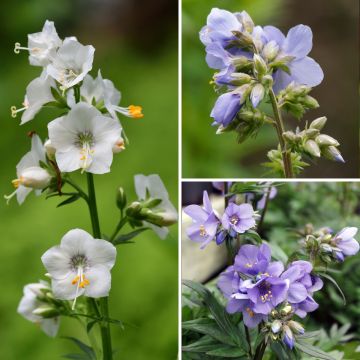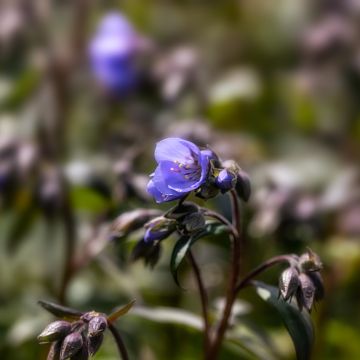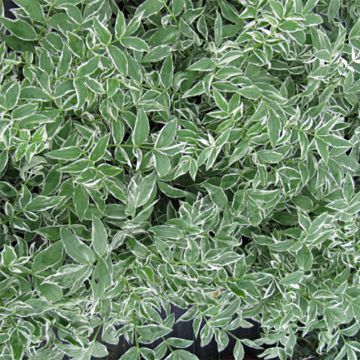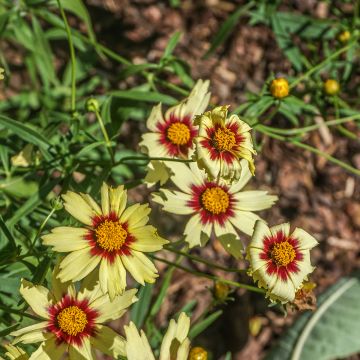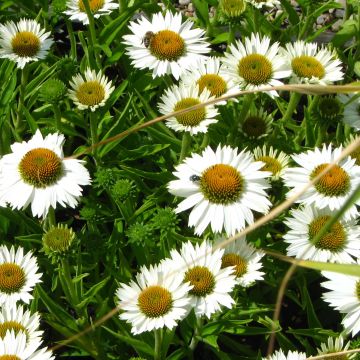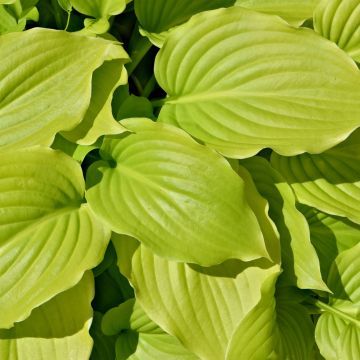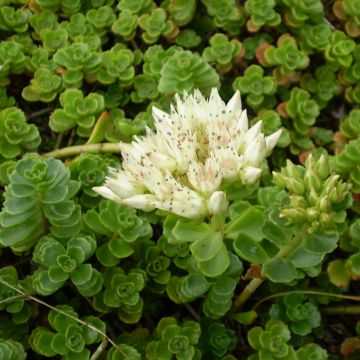

Polemonium reptans Blue Pearl


Polemonium reptans Blue Pearl


Polemonium reptans Blue Pearl


Polemonium reptans Blue Pearl
Polemonium reptans Blue Pearl
Polemonium reptans Blue Pearl
Absinthe Jacob's Ladder, Spreading Jacob's Ladder, Greek Valerian, False Jacob's Ladder, American Greek Valerian, Bluebell, Sweatroot
This item cannot be shipped to the selected country
Delivery charge from €5.90
More information
Schedule delivery date,
and select date in basket
This plant carries a 12 months recovery warranty
More information
We guarantee the quality of our plants for a full growing cycle, and will replace at our expense any plant that fails to recover under normal climatic and planting conditions.
From €5.90 for pickup delivery and €6.90 for home delivery
Express home delivery from €8.90.

Does this plant fit my garden?
Set up your Plantfit profile →
Description
Polemonium reptans 'Blue Pearl' is a variety of creeping Greek valerian with a compact and non-creeping habit, adorned with a particularly bright lavender-blue flowering and elegant, finely cut, light green foliage, gathered in a dense tuft, as elegant as that of a fern. This perennial plant chooses the end of spring to offer its panicles of small, very blue flowers in the shape of hanging cups. Like other polemoniums, it is very hardy and easy to grow in fertile, well-drained and moist soil in a sunny or semi-shaded exposure.
The creeping 'Blue Pearl' polemonium belongs to the Polemoniaceae family. It is a cultivar derived from Polemonium reptans, native to the eastern United States, from Minnesota to New Hampshire, Georgia, Mississippi and west of the Appalachians, where it is usually found in rich and humid undergrowth, often along banks. This perennial forms a prostrate tuft of 40 cm (16 in) in all directions. Completely dormant in winter, the plant quickly completes its growth in spring and early summer, until flowering. Its deciduous foliage is composed of finely cut, flexible pinnate leaves, reminiscent of ferns in shape, with 7 to 9 ovate and pointed, almost glabrous leaflets. They are distinguished by their light green and shiny colour. They are continuously renewed from spring to summer, before disappearing in winter. During the months of June to July, erect floral stems emerge from the foliage, bearing buds that open into small light lavender-blue flowers with white throats, punctuated by yellow-orange anthers. These honey-bearing flowers are heavily visited by bees and butterflies.
Plant Polemonium reptans 'Blue Pearl' in a mixed border or at the edge of a flower bed in association with anemones, pulsatillas or at the base of shrubs or old roses. This variety prefers sunny to semi-shaded exposures to flower well. To brighten up a rock garden, a border of a path, or a light woodland, this selection has no rival. Associate it with corydalis, bleeding hearts, Geranium nodosum, and epimediums. It blends well with different foliage and flower colours and adapts well in a flower pot when placed prominently as a specimen, its light blue flowering attracting attention above the dense mass of its foliage. It is a particularly good plant for decorating the surroundings of water points.
In the past, the dried roots of Polemonium reptans were used in herbal medicine. They were harvested in autumn and then dried for later use.
Report an error about the product description
Polemonium reptans Blue Pearl in pictures




Flowering
Foliage
Plant habit
Botanical data
Polemonium
reptans
Blue Pearl
Polemoniaceae
Absinthe Jacob's Ladder, Spreading Jacob's Ladder, Greek Valerian, False Jacob's Ladder, American Greek Valerian, Bluebell, Sweatroot
Cultivar or hybrid
Other Polemonium - Jacob's Ladder
Planting and care
Polemonium reptans Blue Pearl is easy to grow. It is preferably planted in autumn, in a soil that remains moist but well-draining, in full sun or partial shade. Mark its location as the foliage disappears in winter. Polemoniums do not tolerate the combination of high heat and humidity in regions with hot summers. The foliage can burn under scorching sun. The best results are obtained in regions with cool summers. To prevent excessive spreading of the plant, be sure to remove faded flowers to avoid spontaneous sowing, for a second flowering and better foliage retention. Cut back the plant in autumn. Polemoniums generally do not need to be divided, as they do not like transplanting.
Planting period
Intended location
Care
-
, onOrder confirmed
Reply from on Promesse de fleurs
Summer flowering perennials
Haven't found what you were looking for?
Hardiness is the lowest winter temperature a plant can endure without suffering serious damage or even dying. However, hardiness is affected by location (a sheltered area, such as a patio), protection (winter cover) and soil type (hardiness is improved by well-drained soil).

Photo Sharing Terms & Conditions
In order to encourage gardeners to interact and share their experiences, Promesse de fleurs offers various media enabling content to be uploaded onto its Site - in particular via the ‘Photo sharing’ module.
The User agrees to refrain from:
- Posting any content that is illegal, prejudicial, insulting, racist, inciteful to hatred, revisionist, contrary to public decency, that infringes on privacy or on the privacy rights of third parties, in particular the publicity rights of persons and goods, intellectual property rights, or the right to privacy.
- Submitting content on behalf of a third party;
- Impersonate the identity of a third party and/or publish any personal information about a third party;
In general, the User undertakes to refrain from any unethical behaviour.
All Content (in particular text, comments, files, images, photos, videos, creative works, etc.), which may be subject to property or intellectual property rights, image or other private rights, shall remain the property of the User, subject to the limited rights granted by the terms of the licence granted by Promesse de fleurs as stated below. Users are at liberty to publish or not to publish such Content on the Site, notably via the ‘Photo Sharing’ facility, and accept that this Content shall be made public and freely accessible, notably on the Internet.
Users further acknowledge, undertake to have ,and guarantee that they hold all necessary rights and permissions to publish such material on the Site, in particular with regard to the legislation in force pertaining to any privacy, property, intellectual property, image, or contractual rights, or rights of any other nature. By publishing such Content on the Site, Users acknowledge accepting full liability as publishers of the Content within the meaning of the law, and grant Promesse de fleurs, free of charge, an inclusive, worldwide licence for the said Content for the entire duration of its publication, including all reproduction, representation, up/downloading, displaying, performing, transmission, and storage rights.
Users also grant permission for their name to be linked to the Content and accept that this link may not always be made available.
By engaging in posting material, Users consent to their Content becoming automatically accessible on the Internet, in particular on other sites and/or blogs and/or web pages of the Promesse de fleurs site, including in particular social pages and the Promesse de fleurs catalogue.
Users may secure the removal of entrusted content free of charge by issuing a simple request via our contact form.
The flowering period indicated on our website applies to countries and regions located in USDA zone 8 (France, the United Kingdom, Ireland, the Netherlands, etc.)
It will vary according to where you live:
- In zones 9 to 10 (Italy, Spain, Greece, etc.), flowering will occur about 2 to 4 weeks earlier.
- In zones 6 to 7 (Germany, Poland, Slovenia, and lower mountainous regions), flowering will be delayed by 2 to 3 weeks.
- In zone 5 (Central Europe, Scandinavia), blooming will be delayed by 3 to 5 weeks.
In temperate climates, pruning of spring-flowering shrubs (forsythia, spireas, etc.) should be done just after flowering.
Pruning of summer-flowering shrubs (Indian Lilac, Perovskia, etc.) can be done in winter or spring.
In cold regions as well as with frost-sensitive plants, avoid pruning too early when severe frosts may still occur.
The planting period indicated on our website applies to countries and regions located in USDA zone 8 (France, United Kingdom, Ireland, Netherlands).
It will vary according to where you live:
- In Mediterranean zones (Marseille, Madrid, Milan, etc.), autumn and winter are the best planting periods.
- In continental zones (Strasbourg, Munich, Vienna, etc.), delay planting by 2 to 3 weeks in spring and bring it forward by 2 to 4 weeks in autumn.
- In mountainous regions (the Alps, Pyrenees, Carpathians, etc.), it is best to plant in late spring (May-June) or late summer (August-September).
The harvesting period indicated on our website applies to countries and regions in USDA zone 8 (France, England, Ireland, the Netherlands).
In colder areas (Scandinavia, Poland, Austria...) fruit and vegetable harvests are likely to be delayed by 3-4 weeks.
In warmer areas (Italy, Spain, Greece, etc.), harvesting will probably take place earlier, depending on weather conditions.
The sowing periods indicated on our website apply to countries and regions within USDA Zone 8 (France, UK, Ireland, Netherlands).
In colder areas (Scandinavia, Poland, Austria...), delay any outdoor sowing by 3-4 weeks, or sow under glass.
In warmer climes (Italy, Spain, Greece, etc.), bring outdoor sowing forward by a few weeks.







































